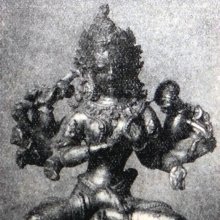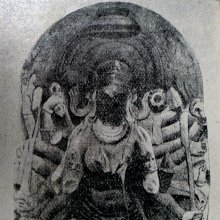Takkiraja, Ṭakkirāja: 5 definitions
Introduction:
Takkiraja means something in Buddhism, Pali, Hinduism, Sanskrit. If you want to know the exact meaning, history, etymology or English translation of this term then check out the descriptions on this page. Add your comment or reference to a book if you want to contribute to this summary article.
Images (photo gallery)
In Buddhism
Tibetan Buddhism (Vajrayana or tantric Buddhism)
Source: archive.org: The Indian Buddhist IconographyṬakkirāja (टक्किराज) presides over the Agni-corner and represents one of the ten deities of the quarters (Dikpāla) commonly depicted in Buddhist Iconography, and mentioned in the 11th-century Niṣpannayogāvalī of Mahāpaṇḍita Abhayākara.—His Colour is blue; he has three faces and six arms.—Ṭakkirāja as the guardian of the Agni corner is very frequently referred to in the Niṣpannayogāvalī.
Ṭakkirāja is described in the Niṣpannayogāvalī (mañjuvajra-maṇḍala) as follows:—
Source: academia.edu: The Structure and Meanings of the Heruka Maṇḍala“Ṭakkirāja is in the Agni corner and is blue in colour. His three faces are blue, white and red. He holds the blue staff, the sword, the jewel and the lotus”.
[In the vajrahūṃkāra-maṇḍala his name is Vajrayakṣa. In the dharmadhātuvagīśvara-maṇḍala he is Vajrajvālānalārka]
Ṭakkirāja (टक्किराज) is the name of a Vīra (hero) who, together with the Ḍākinī named Ṭakkirājī forms one of the 36 pairs situated in the Hṛdayacakra, according to the 10th century Ḍākārṇava chapter 15. Accordingly, the hṛdayacakra refers to one of the four divisions of the sahaja-puṭa (‘innate layer’), situated within the padma (lotus) in the middle of the Herukamaṇḍala. The 36 pairs of Ḍākinīs and Vīras [viz., Ṭakkirāja] are reddish yellow in color; they each have one face and four arms; they hold a skull bowl, a skull staff, a small drum, and a knife.
Source: OSU Press: Cakrasamvara SamadhiṬakkirāja (टक्किराज) is the name of a deity [i.e., oṃ ṭakkirāja hūṃ], according to the Guru Mandala Worship (maṇḍalārcana) ritual often performed in combination with the Cakrasaṃvara Samādhi, which refers to the primary pūjā and sādhanā practice of Newah Mahāyāna-Vajrayāna Buddhists in Nepal.

Tibetan Buddhism includes schools such as Nyingma, Kadampa, Kagyu and Gelug. Their primary canon of literature is divided in two broad categories: The Kangyur, which consists of Buddha’s words, and the Tengyur, which includes commentaries from various sources. Esotericism and tantra techniques (vajrayāna) are collected indepently.
General definition (in Buddhism)
Source: Wisdom Library: Dharma-samgrahaṬakkirāja (टक्किराज) or Ṭarkirāja refers to the fifth of the “ten wrathful ones” (daśakrodha) as defined in the Dharma-saṃgraha (section 11). The Dharma-samgraha (Dharmasangraha) is an extensive glossary of Buddhist technical terms in Sanskrit (e.g., daśa-krodha and Ṭakkirāja). The work is attributed to Nagarguna who lived around the 2nd century A.D.
Languages of India and abroad
Sanskrit dictionary
Source: Cologne Digital Sanskrit Dictionaries: Edgerton Buddhist Hybrid Sanskrit DictionaryṬakkirāja (टक्किराज).—name of a Buddhist deity (one of the krodha): Sādhanamālā 137.10 et al. Also Acalaṭak°, Acaraṭarkirāja, qq.v.
Sanskrit, also spelled संस्कृतम् (saṃskṛtam), is an ancient language of India commonly seen as the grandmother of the Indo-European language family (even English!). Closely allied with Prakrit and Pali, Sanskrit is more exhaustive in both grammar and terms and has the most extensive collection of literature in the world, greatly surpassing its sister-languages Greek and Latin.
See also (Relevant definitions)
Ends with: Acalatakkiraja, Achalatakkiraja.
Full-text: Acalatakkiraja, Tarkiraja, Vajrayaksha, Takkiraji, Hridayacakra, Vajrajvalanalarka.
Relevant text
Search found 1 books and stories containing Takkiraja, Ṭakkirāja; (plurals include: Takkirajas, Ṭakkirājas). You can also click to the full overview containing English textual excerpts. Below are direct links for the most relevant articles:
The Indian Buddhist Iconography (by Benoytosh Bhattachacharyya)
Related products




